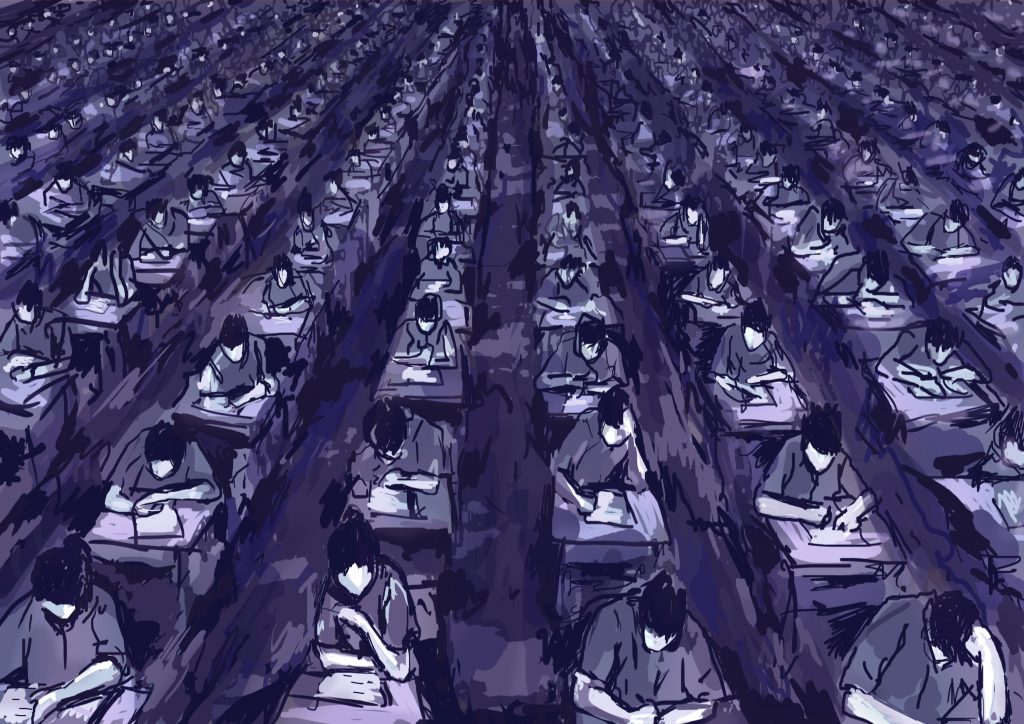Every year, the whole of China comes to a standstill on 7 and 8 June. On these dates there is nothing more important in the Asian country than the Gaokao, which is the Mandarin name for the dreaded university entrance exam. A demanding university entrance exam, popularly known as the “battle of the future”, in which students literally put their future on the line. The success or failure of their professional and personal lives, and even their future marriages, depends on their marks.
This academic event, which was introduced in 1952 and interrupted during the decade of the Cultural Revolution, has been held continuously since 1977 and has become the largest university entrance exam in the world. Not only because of the number of applicants (this year more than 10 million students are taking the exam), but also because of the huge number of people it attracts, including students, their families and teachers who accompany the future university students to the place where the exams are held.
This mobilisation can be explained by the very social structure of the country, where having a university degree is considered a guarantee of a good job and a decent salary. These are goals that many young women set as indispensable conditions for their suitors in order to get married and start a family in the future. And many applicants have to study an average of ten hours a day for years to prepare themselves to pass the Gaokao with flying colours.
But what does this exam, which has been criticised for the pressure it puts on students and its exaggerated control measures, consist of? Well, it consists of four tests lasting between two and three hours each, which take place over two days and test the students’ knowledge of Chinese, mathematics and a foreign language (usually English). In addition, there are questions on physics, chemistry and biology if they have opted for science, or geography, history and politics if they have opted for humanities.
The tests are multiple-choice, except for the Chinese test, in which the candidate must develop a topic in one hour, choosing between two options, whichever is more elliptical. So, for example, in 2015, you had to choose between: What colour are the wings of a butterfly? and Who do you admire most, a biotechnology researcher, a technical engineer or a photographer?
Anguish and suicide
The maximum score is 750 points, and the higher the score, the better the chances of being admitted to the best universities in the country and thus securing a bright future. This is the dream of the millions of students who take part in the Gaokao, but it is not easy to achieve, as due to the number of places available, one in four applicants will not make the cut-off mark.
They are all anxious that they might not make the cut and let their parents down. They know that their parents have sacrificed their lives for them to study and have pinned their hopes on them getting into university, succeeding in life and repaying those sacrifices in the form of help to get them through old age without hardship. It is a concern that especially gnaws at the hearts of rural and emerging middle-class families, who are aware that this offspring is their life insurance, as a consequence of the one-child policy that prevailed in China between 1979 and 2015.
These expectations explain why, on the days of the exam, many families crowd around the centres where the Gaokao takes place, burning incense to bring good luck to their children, or waiting for them to come out to get their first impressions of the exam.
These situations generate an anxiety that grips many young people and which many experts believe to be at the origin of 90% of suicides among Chinese students, according to the Blue Book of Education published annually by the Chinese government.
Special measures
In an attempt to prevent these failures, the authorities do not hesitate to use all possible means to encourage students to concentrate. These days, the police are stationed at the entrances to high schools, traffic is diverted and drivers are asked to avoid honking their horns. An obsession with preventing noise leads to construction work being halted, trains being stopped or, as happened in 2013 in Qingdao, frogs being poisoned to prevent their croaking from disturbing those taking exams. Medical teams and ambulances are even stationed at school gates in case students feel unwell.
Transport is also arranged so that students can arrive in good time for the tests. Special corridors are opened in metro stations and special trains and coaches are organised to speed up travel. Many taxi drivers offer to transport students free of charge and the police even escort those who have fallen asleep or lost their way.
These initiatives fall short, however, of the measures taken in South Korea on the day of the university entrance exam. In South Korea, take-offs and landings are delayed by half an hour at all the country’s airports, and the opening of offices, shopping centres and the Seoul Stock Exchange is delayed by an hour in order to limit traffic jams and allow students to arrive on time for their exams. The unlucky ones can even call an emergency number so that the police can send a car and motorists to clear the way for them.
Tight security
But if the facilities for students to get to the exam are at their best, so are the security measures. Everyone has a lot at stake in the Gaokao and the temptation to cheat is enormous. To prevent this, the authorities are taking tougher measures every year, to the extent that in 2016 they decided to include in the penal code that cheating in the entrance exam is a crime and can be punished with up to seven years in prison. This measure is especially aimed at the mafias that try to sell gadgets to students to help them pass.
In this regard, measures to prevent cheating and cheating are becoming increasingly sophisticated. Many schools have their own security measures. They have closed circuits to monitor students and systems that detect any radio signals from hidden electronic devices. Drones are even used to track signals near the buildings where the tests take place.
To gain access to the examination rooms, students must pass through a number of checks. They are inspected by a facial recognition device, in order to avoid impersonation, and must leave their mobile phones and electronic watches behind. Their clothing, including underwear, is also scanned to check that there are no secret pockets or devices concealed in jewellery, glasses or even bra underwires in the case of girls.
The preparation for the exam is also closely scrutinised by the authorities. The questions, which are different in each province, are monitored right up to the moment they are distributed to the students. The teachers who prepare them are severely scrutinised to prevent leaks and the papers are escorted to the schools by security guards and monitored by GPS trackers.
An environment, in short, that does nothing but contribute to a huge psychological burden on students. The entrance exams have become a legend and make Chinese teenagers shiver when they hear the word Gaokao.



